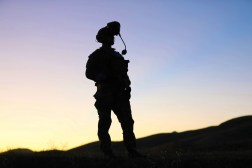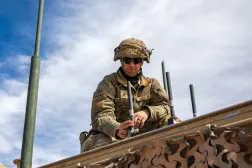Army looking to expand aerial tier of network to gain more feedback

After testing networking and command-and-control capabilities aboard airborne platforms, the Army could be sending those packages outside the U.S. for further feedback from units.
Historically, aerial platforms only had chat functions and could only send position location information. But this summer, 2nd Brigade, 101st Airborne Division conducted a 500-mile air assault from its home station at Fort Campbell, Kentucky, to Fort Johnson, Louisiana, to kick off its Joint Readiness Training Center rotation. For that trek, the Army’s network team outfitted helicopters with new communications equipment — such as putting HMS manpack radios, the same that are used by dismounted soldiers, into helicopters, providing MUOS beyond-line-of-sight satellite communications — that yielded levels of data and connectivity not seen before.
“What we’re working on right now is taking that particular set and looking at possibility of deploying it downrange, so we can continue to get feedback. Also, we’re looking at ruggedizing and then potentially coming up with a core set of kit that will go to all of our [transforming-in-contact] units,” Col. Shermoan Daiyaan, project manager for mission command at program executive office for command, control, communications and network, said in an interview at the annual AUSA conference last week. “We’re trying to get to where we will provide all of the [transforming-in-contact] units enough capabilities to where we can continue to get feedback, to include somebody to be able to take it downrange.”
Daiyaan was referring to the aerial defense kits that were outfitted to the aircraft that could possibly be deployed outside the U.S.
Transforming-in-contact refers to the Army’s plan to use deployments and troop rotations to test new equipment — mainly commercial off-the-shelf gear — that could allow units to be more responsive on a dynamic battlefield. It has initially focused on three main areas where officials say the Army needs to be faster and more adaptable when it comes to delivering equipment to forces, due to how challenging the threat environment is and the cat-and-mouse aspect of countering opponents’ moves: unmanned aerial systems, counter-UAS and electronic warfare.
So far, the experimental units include 2nd Brigade, 101st Airborne Division — the first mobile brigade combat team — 2nd Brigade, 25th Infantry Division — experimenting as the light brigade combat team — and 3rd Brigade, 10th Mountain Division.
Officials explained that these capabilities provided an unprecedented level of communication and situational awareness from the air picture that wasn’t previously possible.
“If you were at JRTC, you would have seen for the first time both voice and data integration between our aerial platforms and our ground formations. And it was powerful. No more having to pick up a handset and say, ‘This is where I’m at,’” Lt. Gen. John Morrison, deputy chief of staff, G6, said in September. “Everybody having common [situational awareness] of what is happening, whether you’re in the air or on the ground.”
Updated capabilities allowed forces to maintain a solid common operating picture to effectively make decisions at the speed of need, officials said.
“The commanders at echelon were able to make decisions without picking up a radio because they had the awareness and understanding of where they were in time and space, because of all the data they had at their fingertips that they could do that,” Maj. Brad Anderson, assistant product manager for helicopter and multi-mission radios, said. “Where, traditionally, somebody [would] have to pick up a phone or pick up a radio and say, ‘Hey, you, this is me,’ and they’d have to respond to get a SITREP [situational report]. Commanders now with this capability, with the aerial tier, we’re able to synchronize effects to deliver those close combat forces into the box during that period of darkness.”
One of the key lessons the Army learned through this process is the TSM waveform for software-defined radios worked very well in the air.
“Our data speaks to the ability to talk across the tyranny of distance, in a long-range, large-scale air assault. [It] provides for its commanders and effectively provides them with a continuous data stream and means to communicate across time and distance so that they can effectively make those decisions,” Anderson said.
This unprecedented level of situational awareness didn’t mean there weren’t challenges, however.
The software used to underpin those command-and-control tools was spread across three different programs that live within various program executive offices.
“One of the friction points … one of the challenges we had was our TAK [Tactical Assault Kit] baseline. Within that, just in the back of an aircraft, you had Air Warrior, Nett Warrior devices on soldiers and you had Mounted Mission Command. All three were on different baselines and had interoperability challenges,” Daiyaan said. “We got all these different systems on different program offices, different PEOs, different budget lines. We need to get this under control so we can work more seamlessly for a commander. That was one of the big friction points that we experienced.”
As the Army is working to modernize, officials have come to the realization that the entire acquisition community must be integrated together. Daiyaan is now in charge of leading the enterprise between several program executive offices to serve as the focal point of integration.
Officials also noted that some of the feedback from troops included there needs to be better antenna placement optimization on the helicopters in order to enable stronger signals, particularly MUOS.
Some of the other soldier feedback included various communications options for forces, something the military refers to as PACE, or primary, alternate, contingency and emergency communications.
“Leaders have a lot of PACE. It’s like double PACE, PACE squared,” Daiyaan said. When “the commander had a couple of dead spots that he would hit on the tactical systems, then he was able to leverage the [in-case-of-emergency] capabilities provided to do radio over IP. When the radio was struggling, he was able to pick up his phone and hit the radio net and go up and over [mobile broadband kit] and back out … We have really evolved away from transport agnostic to really transport diversity.”
Elsewhere within the aerial tier of the network, the Army is continuing to experiment with its aerial tier network extension concept, which envisions putting radios in the air to allow greater connectivity of forces that might be dispersed on the battlefield, or, in an Asia-Pacific scenario, thicken the network from dense foliage interference.
This differs from other efforts previously to use tethered drones given these systems — particularly the K1000ULE from Kraus, a Group 2 UAS that is solar powered and can fly at 18,000 feet for very long periods of time — can go much higher.
Daiyaan said that went out to the 25th Infantry Division in the Pacific, and “with the TSM in it continues to win” because it can get above the canopy and is another tool in the commander’s inventory.
Questions the Army is looking to answer through continued experimentation on that front include: Who owns the drones? Is it the network staff section at a particular echelon? Is it an operational commander that can choose to put other payloads on them?
A commander might have to be the owner given operational considerations when deploying them, such as electronic signature, their likelihood of being shot down or if they’ll be contested.
“Those are all part of the decisions that we’re trying to work through,” Daiyaan said, adding PEO Aviation owns the asset, and project manager for tactical radios within C3N is supporting the effort with the radio.






